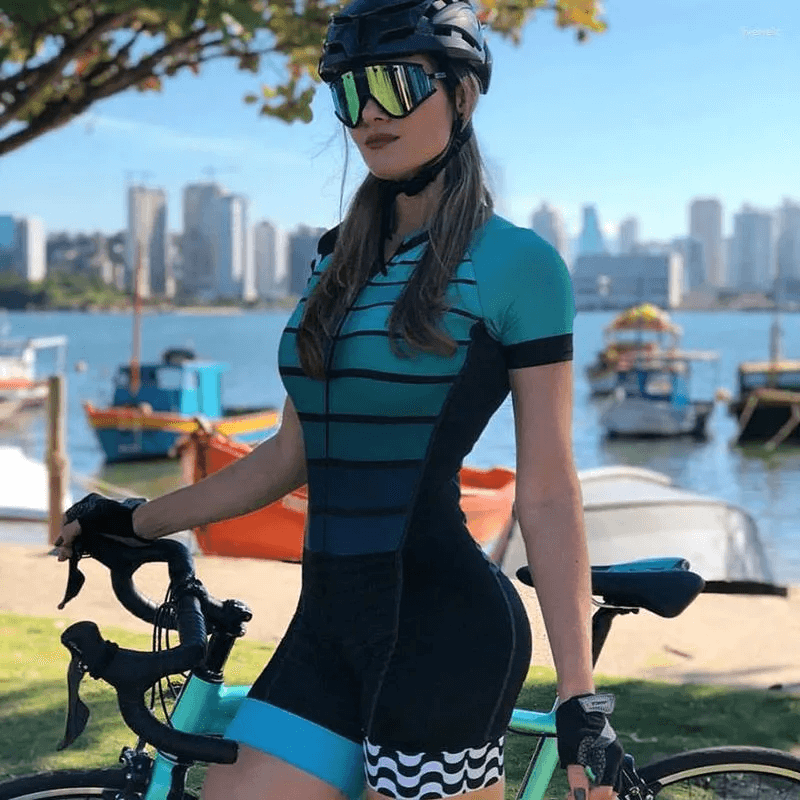Popular and interesting activity requiring certain gear for performance, comfort, and style is cycling. Although the basic goals of men’s and women’s Cycling wear are the same, there are numerous important variations between the two. Knowing these differences will improve the riding experience for both sexes in terms of design, fit, or utility. The distinctions between men’s and women’s cycling gear will be discussed in this post, stressing the special selling features of every kind of product and the need of selecting the appropriate gear for best performance.

Design and fit: customizing for performance and comfort
One of the most obvious variations between men’s and women’s Cycling wear is fit. Women’s Cycling wear is made to fit the special curves of the female body. It comprises better fitting waistlines, more defined hip regions, and smaller shoulder sections. Men’s bicycle gear, on the other hand, fits straight and has a wider shoulder breadth, therefore addressing their body proportions.
This customized fit lowers friction, increases comfort, and sharpens aerodynamics. Both styles provide best mobility and support, but for professional races and lengthy rides especially tailored tailoring is essential. The correct fit lets riders enjoy their time on the bike, therefore preventing pain from poorly fitting gear.
Designed for comfort, chamois padding
Comfort on lengthy rides depends much on the chamois padding used in Cycling wear. Particularly around the pelvic and sit bone areas, women’s Cycling wear generally includes a chamis made with a distinct form and thickness to support their feminine anatomy. Men often have larger padding in locations that line up with their body.
The purpose of the padding is to reduce friction and provide cushioning, therefore enabling riders to remain comfortable during long riding times. Preventing saddle sores and maximizing a pleasant riding experience depend on selecting the correct chamois cushioning.
Materials and Breathability: Boosting Performance
Men’s and women’s Cycling wear is composed of breathable, moisture-wicking fabrics meant to keep bikers cool and dry. To accommodate the variations in body heat distribution between sexes, women’s clothing often use lighter textiles in certain regions. Men’s clothing could stress durability and wind resistance, while women’s cycling attire might include more breathable mesh panels to guarantee ventilation.
Advanced textiles like Lycra, Spandex, or Merino wool help both kinds of gear; yet, the differences in fabric weight and structure affect comfort and performance in varied environments.
Waistband Design: Customizable Comfort Improvements
Men’s and women’s styles of Cycling wear have somewhat different waistbands. Particularly during hard riding sessions, women’s cycling attire often has a high-rise waistband, which provides more support to the lower abdomen and helps maintain a secure fit. Men’s Cycling wear usually has a more conventional waistline with a lower rise and more expansive shape to fit the masculine body type.
Comfort depends on the design of the waistline, particularly on long rides or in aggressive riding posture. Correct waistline fit guarantees that riders do not feel pinching or shifting, therefore preventing any performance distraction.
Style & Aesthetic: Fashion Meets Utility
Although most bikers’ main focus is performance, style is very essential in riding gear. Appealing to people who seek both flair and utility, women’s cycling apparel often provides a greater spectrum of colors, patterns, and cuts. Men’s Cycling wear, on the other hand, often follows more subdued tones like navy, grays, or black.
Both sexes gain from the fashionable designs of current bicycle gear, which blends use with style, despite their different tastes. High-end companies guarantee bikers can look beautiful and ride well on the road by providing a selection of styles that mix form and utility.
Pockets and Zippers: Common Sense for Extended Rides
For little needs like energy gels, keys, or a phone, cyclists sometimes require storage space. Though the style and location vary, both men’s and women’s Cycling wear includes pockets. Smaller, more subdued pockets on women’s Cycling wear help to fit the usually smaller frame of female riders. These pockets are designed not to impede the garment’s comfort or fit.
Men’s Cycling wear, on the other hand, can include more pockets or extra rear storage spaces meant to fit the bigger frame and provide more room for objects. These variations both preserve comfort and efficiency and reflect the practical demands of riders.
Environmental Impact: Cycling wear Design’s Sustainable Character
Many companies are including environmentally friendly materials and production techniques in men’s and women’s cycling clothing as sustainability rises as a major issue in the fashion and sports sectors. Low-impact colors, organic cotton, and recycled textiles are being utilized more and more to lessen the carbon footprint of riding gear.
Still, there are minute variations in the way these elements are applied. Emphasizing lightweight materials that nonetheless provide the required performance qualities, women’s cycling gear often includes more environmentally friendly choices. Men’s cycling gear often consists of materials meant for performance and durability, which also help sustainability by providing long-lasting, highly performing gear.
Both kinds of equipment are moving toward environmentally friendly manufacturing techniques so that riders could enjoy their activity and simultaneously help the surroundings.


Making the correct gear choice depends on knowing the variations in cycling wear between men and women. From customized fits to innovative padding designs, the correct cycling gear improves bike comfort, performance, and appearance. Choosing the gear that best fits your body type, riding style, and environmental preferences will make all the difference whether you ride often or just beginning.
High-performance fabrics, more comfort features, and fashionable designs are driving both men’s and women’s cycling gear forward. Selecting appropriate cycling gear based on your tastes will enable you to cycle faster, longer, more comfortably, thereby guaranteeing a better whole riding experience.



